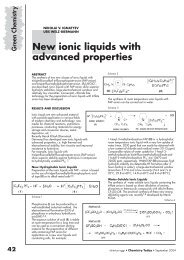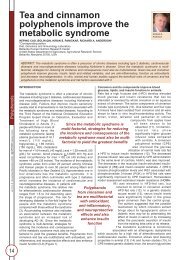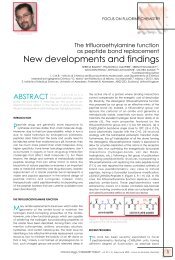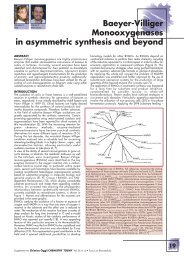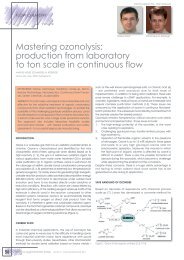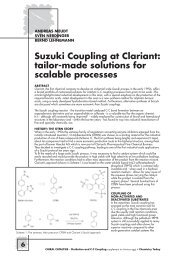Lake Como 2|4 October 2011 - CHIMICA Oggi/Chemistry Today
Lake Como 2|4 October 2011 - CHIMICA Oggi/Chemistry Today
Lake Como 2|4 October 2011 - CHIMICA Oggi/Chemistry Today
Create successful ePaper yourself
Turn your PDF publications into a flip-book with our unique Google optimized e-Paper software.
On-line NIR spectroscopy to control a seeded API crystallization step<br />
Cédric Schaefer, Clémence Lecomte, David Clicq, Alain Merschaert, Edith Norrant<br />
Biopharma Process Sciences, UCB Pharma S.A., Braine-l’Alleud, Belgium<br />
Process Analytical Technologies (PAT) has emerged as a prominent and powerful tool in the development and manufacture<br />
of pharmaceutical products. Numerous examples have been reported on the use of PAT in recent years but fairly limited<br />
on the use of quantitative on-line NIR methods in chemical processes.<br />
We have recently developed an on-line quantitative NIR method for the seeded crystallization of an API that required a tight<br />
control of solvent composition and concentration. Feasibility of the method was initially demonstrated on laboratory and<br />
technical pilot plant batches with a lab scale spectrometer and probe. In a second phase, the manufacturing equipment<br />
was purchased and implemented in c-GMP environment following ICH qualification requirements.<br />
The presentation will focus on the methodology used for the development of the calibration model which encompasses<br />
experimental design with statistical analysis (DoE), Principal Component Analysis (PCA)<br />
and Partial Least Square (PLS) regression methods.<br />
POSTER POSTER POSTER POSTER POSTER POSTER POSTER POSTER POSTER POSTER POSTER POSTER POSTER POSTER POSTER POSTER POSTER POSTER POSTER POSTER POSTER POSTER POSTER POSTER POSTER POSTER POSTER POSTER POSTER POSTER POSTER POSTER POSTER POSTER POSTER POSTER POSTER POSTER POSTER POSTER POSTER POSTER POSTER POSTER<br />
11 11 11 11 11 11 11 11 11 11 11 11 11 11 11 11 11 11 11 11 11 11 11 11 11 11 11 11 11 11 11<br />
Flow-type multi-tubular reactor modeling: the effect of non-uniform radial<br />
E.V. Ovchinnikova, V.A. Chumachenko<br />
Boreskov Institute of Catalysis SB RAS (BIC), pr. Akademika Lavrentieva, 5, Novosibirsk, 630090, Russia<br />
Production of industrial chemicals is infl uenced by fl uctuations in the market demand. At a chemical plant, the production capacity and<br />
consumption of raw materials may change a lot depending on the market situation. For widely used fl ow-type multi-tubular reactors,<br />
variations in raw gas feed can provoke critical regimes, and for highly exothermic processes - even runaways.<br />
In the present work, we study reasons of occurrence of critical reactor regimes on the example of a large-scale process of formaldehyde<br />
production at one of the Russian industrial enterprises and propose possible preventing measures.<br />
The production of formaldehyde in this study is carried out in a multi-tubular fi xed bed reactor by means of oxidizing the methanol to<br />
formaldehyde over metal oxide catalyst. This reaction is exothermic; heat withdrawal is done by the DOWTHERM-type high boiling<br />
organic heat transfer fl uid circulating between the tubes.<br />
POSTER POSTER POSTER POSTER POSTER POSTER POSTER POSTER POSTER POSTER POSTER POSTER POSTER POSTER POSTER POSTER POSTER POSTER POSTER POSTER POSTER POSTER POSTER POSTER POSTER POSTER POSTER POSTER POSTER POSTER POSTER POSTER POSTER POSTER POSTER POSTER POSTER POSTER POSTER POSTER POSTER POSTER<br />
12 12 12 12 12 12 12 12 12 12 12 12 12 12 12 12 12 12 12 12 12 12 12 12 12 12 12 12 12 12 12 12 12 12 12 12 12 12 12 12 12 12 12<br />
Our QbD approach for model and method validation will also be discussed as well as the<br />
results of the risk analysis performed to define the potentially influential noise as well as<br />
controlled and experimental parameters to include in the calibration. The robustness of<br />
the analysis has thus been constructed into the model development.<br />
Finally, some key learning points from the implementation of an on-line analysis in a<br />
c-GMP environment will be presented.<br />
The performance analysis of the fl ow-type multi-tubular reactor is based on an extended continuous<br />
2D model of heat and mass transfer. The model considers the variation of the gas linear velocity<br />
along the tube’s radius and the dependence of the radial and the axial thermal conductivity on<br />
the gas linear velocity in the tubes and on the parameters of the dispersion medium.<br />
It is established that a decrease in production capacity accompanied with decrease in gas fl ow<br />
feed in the reactor leads to a decrease in the gas linear velocity, which in its turn, decelerates<br />
the heat transfer. The study of the reactor’s mathematical model considering non-uniform radial<br />
heat transfer has exhibited the dependence between the decrease in gas fl ow feed and the<br />
elevation of maximal temperature in the hot spot of the catalyst layer. On a real-world multitubular<br />
reactor, we observe that these changes and irregularities of stream distribution can lead<br />
to critical operating regimes.<br />
29<br />
<strong>Lake</strong> <strong>Como</strong><br />
<strong>2|4</strong> <strong>October</strong> <strong>2011</strong>



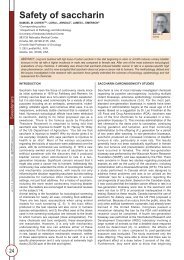
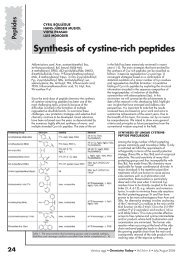
![Pietro Delogu [modalità compatibilità]](https://img.yumpu.com/12255149/1/190x135/pietro-delogu-modalita-compatibilita.jpg?quality=85)
